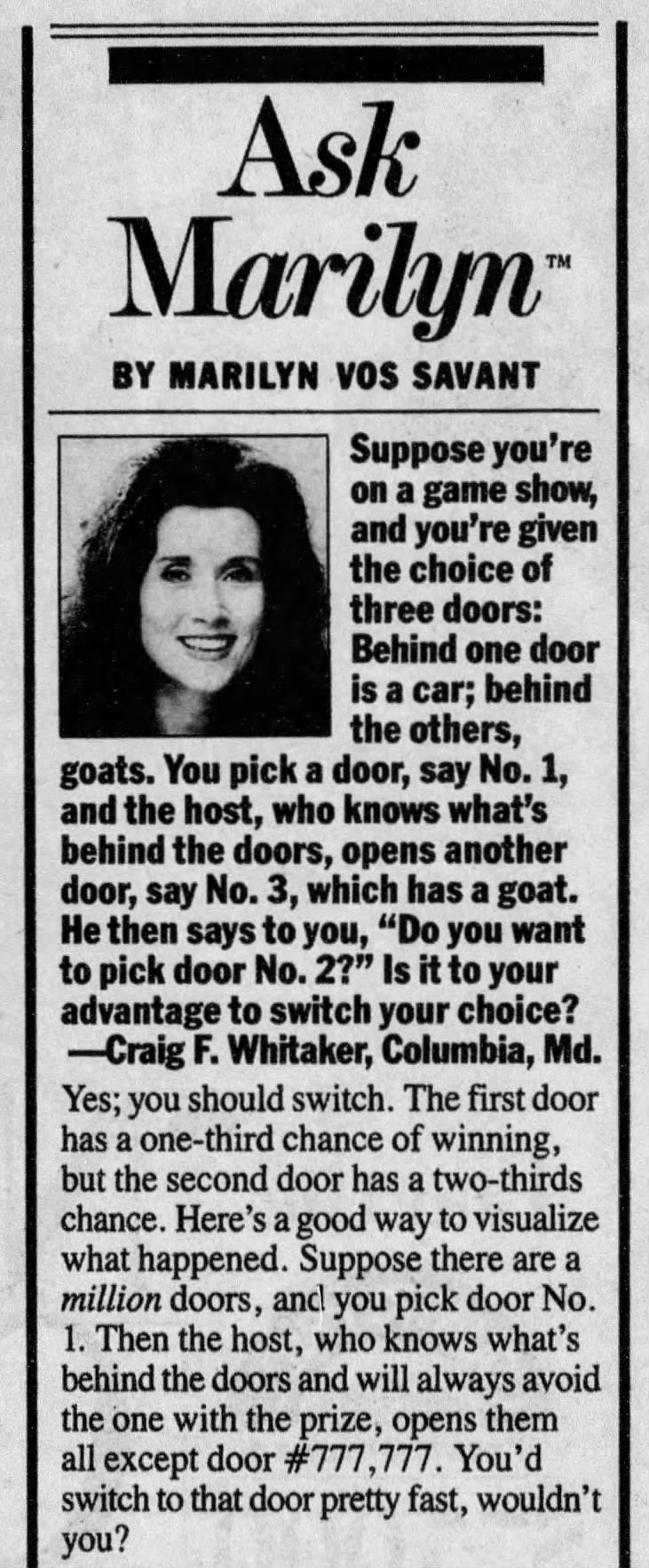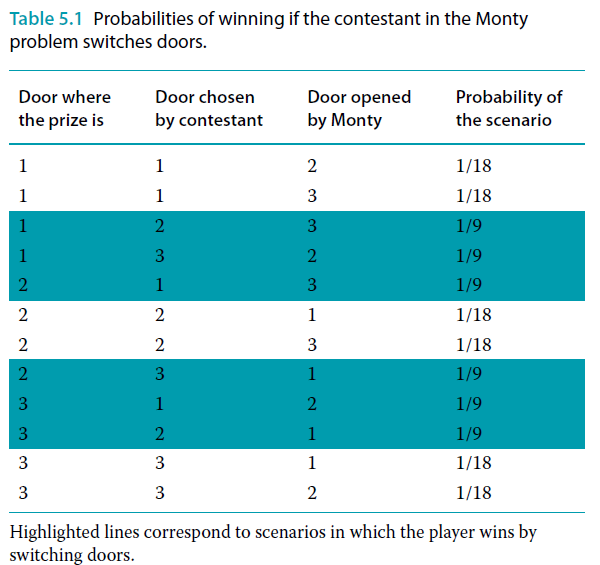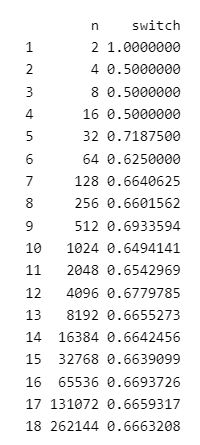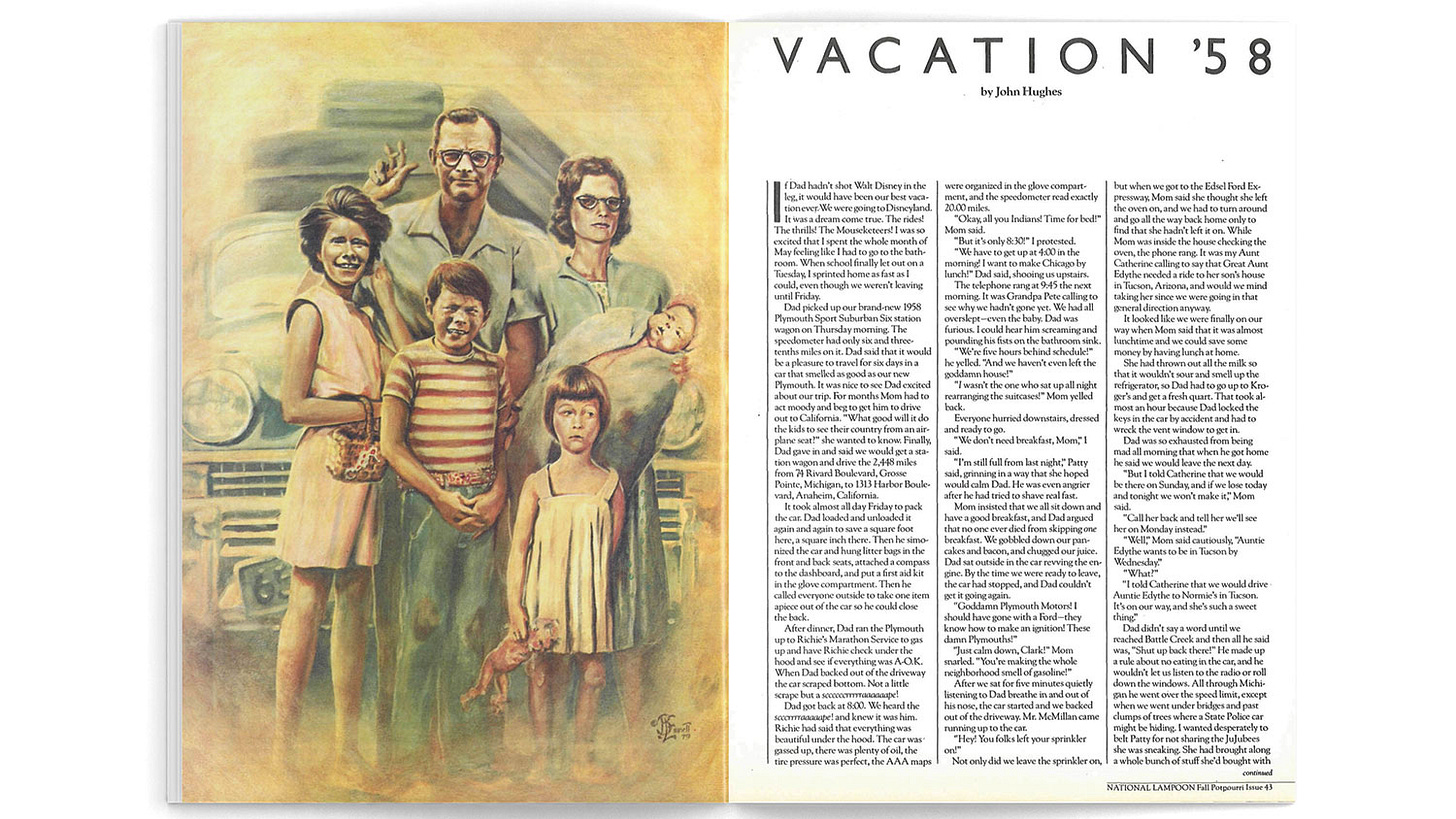Weekly Geekly Rundown for June 21, 2024
Sorry for the late Weekly Geekly Update, but we had friends visiting from out of state and were visiting many of the beautiful locals in Western Idaho like the falls at 1,000 Springs Park pictured above.
Because I wax long on Monty Hall in this one, there will be no responses to film reviews. That will have to wait until this Friday. That doesn’t mean there isn’t some cool stuff below. There is. There are just fewer sections than normal.
Cones Glorious Cones
Long time readers know that I love learning about the ways that our intuitions conflict with reality. When I first read Daniel Kahneman’s Thinking, Fast and Slow I was amazed at how bad the human mind is at statistical thinking. Sure, I’d witnessed it first hand on both the role playing game table and at the casino as a 21/Craps dealer.
When I worked as a croupier, people would frequently pick up the dice after rolling 20 or so rolls without a 7 and ask me, “What do you think the odds are that I’ll roll a 7?” After telling them that it is unlucky to be superstitious, I’d tell them that it was a 1 in 6 chance. They’d look at the roll counter the casino smartly put up next to the table and see how many rolls the hand had lasted and would scoff, expecting to roll a 7 and toss a sucker bet against a 7 or 11 to cover their Pass Line bet (typically without odds) only to roll one of the other 28 possible outcomes (11 having 2 and 7 having 6 possibilities). Eventually, the 7 would come up and the hand would end. They’d say something like, “it’s a good thing I bet the 7 and 11 on that roll because that bet made all the difference” and I’d once again remind them that it is unlucky to be superstitious.
Dice don’t remember the last number rolled and that has no impact on future rolls. If you’ve rolled a single die 10 times and rolled a 6 every time, the odds are still 1 in 6 that you’ll roll a 6 on the next roll. But our mind tells us otherwise. When it comes to games, and game design, I have two go to books that discuss probabilities in an accessible and entertaining way. The first is Tabletop Wargames: A Designers’ & Writers’ Handbook by Rick Priestley and John Lambshead. Rick Priestley is the man who designed Warhammer Fantasy Battles and Warhammer 40k and he knows a thing about a 6-sided die. The second is Reiner Knizia’s Dice Games Properly Explained. Reiner Knizia is a prolific designer and this book has not only a good section on probabilities, but it has a lot of fun games you can play with 6-sided dice.
Both of these books help to break one’s mind free from the “dice have memory” mentality without being text books on probability or statistics. They have information on probabilities, but it is within the context of fun and doesn’t rely on higher mathematics to demonstrate how probabilities work. Buy them.
Speaking of good books on probabilities and how our intuitive sense can mislead us, Probability, Decisions and Games: A Gentle Introduction using R by Abel Rodríguez and Bruno Mendes is a double godsend. First, it’s a great book on probabilities and uses games to teach how they work. Second, it’s a very good introductory book on how to program simulations in the R Programming language. It was an invaluable book in my early days of learning the language and while I’ve still got a lot to learn, this book helped give me a solid foundation in how to use it for simulations.
One of the simulations they include in Probability, Decisions, and Games is the classic Monty Hall problem. The Monty Hall problem is a key example of how we misinterpret probabilities. For those who don’t know, the problem is based on the television show Let’s Make a Deal where host Monty Hall shows a contestant three doors. Behind one of those doors is a BRAND NEW CAR. Behind the other two are goats. The contestant picks one door. Monty then opens one of the other doors revealing one of the two hidden goats and asks if the player wants to switch the door they picked.
What do you think they should do?
You might think that Monty having shown you where one of the two goats is means that it doesn’t matter if you switch or not, however it matters a lot. In September of 1990 an interesting Ask Marilyn column was run in Parade Magazine. The Marilyn in question was Marilyn vos Savant, a woman who claimed to have the highest I.Q. ever recorded. She received a question from a viewer regarding the Monty Hall problem and provided her counterintuitive solution.
Her solution caused quite a stir and received several responses from academics who stated that she was wrong. Since she was right, and she was, she held her ground and tried to convey several different proofs to assure people of her accuracy including the example in her answer. It didn’t take long before Morgan, Chagantry, Dahiya, and Doviak (all Professors in the Department of Mathematics and Statistics at Old Dominion University) to argue in The American Statistician that she was indeed correct, but only if you assume conditional probability which does apply due to Monty knowing his revealed door has no prize and he always selects a no prize door. Their response states, “In general, we cannot answer the question ‘What is the probability of winning if I switch, given that I have been shown a goat behind door 3?’ unless we either know the host's strategy or are Bayesians with a specified prior.” The problem with that critique, as you can see from her example, is that we do know the host’s strategy.
It seems to me that their argument was more of a defense of fellow academics who looked foolish in arguing against Marilyn than an actual rebuttal to her response. She was, in fact, correct that you should always switch. They would have felt less need to defend academia had they looked to an earlier issue of The American Statistician in 1975 when Steve Selvin, a very well respected biostatistician, provided a simple solution (similar to one of those given by Marilyn) in a Letter to the Editor entitled A Problem in Probability. His argument presents a matrix of possibilities, instead of a text description, that makes it easy to see.
Contrary to the Old Dominion Professors’ assertions in their article, her example was a good one to use even if she was reductive in her telling of it. Numberphile, a YouTube channel I adore, has a great video discussing the problem that includes both Selvin’s solution and Marilyn’s 100,000 door scenario, demonstrating the accuracy of her intuition.
In the book on Probability and Games I mentioned earlier Rodríguez and Mendes provide two ways of solving the problem. The first is the same solution that Selvin offered above, thought presented in an even nicer table format.
The second method of solving the dilemma offered by Rodríguez and Mendes is to “simulate” multiple repetitions of the actual event and to see what the results would be. This was the second solution that Marilyn offered, and if you play her simulation you can see that it does work. Rodríguez and Mendes offer a better designed simulation though and I’m providing the R Programming Language code for that simulation below.
door <- seq(1,3)
n = 10000
winifswitch = rep(FALSE, n)
for(i in 1:n){
prizelocation = sample(door, 1)
contestantchoice = sample(door, 1)
if(prizelocation==contestantchoice){
dooropened = sample(door[-contestantchoice], 1)
}else{
dooropened = door[-c(prizelocation,contestantchoice)]
}
doorifswitch = door[-c(dooropened,contestantchoice)]
winifswitch[i] = (doorifswitch==prizelocation)
}
sum(winifswitch)/n
The code is very simple in design. It randomly simulates 10,000 plays of the Monty Hall scenario. After simulating those 10,000 plays, it divides the number of times the player won when switching by the total number of plays. Let’s just say, it’s 2/3 of the time. If you’ve got a copy of R-Studio, you can copy and paste the code and it will run for you.
If you want a slightly fancier simulation Rory Winston of the Research Kitchen has a slightly more detailed version of the simulation that demonstrates not only that Marilyn was right that switching was the correct strategy, but how more and more plays converge on the real answer. His simulation presents several examples ranging from playing the game once to playing it 65,000 times. I updated the code to include up to 262,144 plays of the game because you really begin to see the results converge on the real odds. My code for that is listed below and I like it even better than the Rodríguez and Mendes solution because it creates a function and an object and clearly defines each task.
classic_monty <- function() {
# Assign the prize
prize <- sample(1:3,1)
# Pick a door
choice <- sample(1:3,1)
# Monty picks a door
monty <- sample(c(1:3)[-c(choice,prize)], 1)
return(ifelse(prize!=choice, "Switch", "Stick"))
}
classic_monty()
classic_monty()
classic_monty()
n <- 2^(1:18)
runs <- data.frame(n=numeric(), switch=numeric())
for (trials in n) {
run <- table(replicate(trials, classic_monty()))
runs <- runs |> add_row(n=trials, switch=(sum(run["Switch"]))/trials)
}
# Handle zero-occurrence trials
runs[is.na(runs)]<-0
runsConditional probabilities like this, and like “false positive rates,” are just one area where our pattern seeking mind is bad at finding the right answer. We are also terrible at judging the volume of portions of a cone and how it changes from the base to the tip. We know there are differences, but not how big that difference is. The Numberphile has a great video on this.
Yes, that was a lot of talk about probabilities just to set up a video about how Cones are weird. That’s how my mind works though, making odd connections on a shared point. Humans are great at recognizing some patterns, which makes us very confident that we recognize all kinds of patterns well. Sadly, we don’t and this leads us to make bad judgements. That’s why simulations and the scientific method are the best way to be certain. Our biases are everywhere and they aren’t just due to ideology. Often, they are just due to our very human biology.
Glimpses from the Substackosphere and Bloggerverse
of has a great entry discussing David Nett and Todd Stashwick’s new ProgCore Kickstarter that combines prog rock and role playing in a new role playing endeavor. David is a long time friend of mine with whom I recorded three Dungeons and Dilemmas podcast segments for my Geekerati Podcast. The first discussion was back in episode 162. The main segment that episode covered Tiny d6 games, but the Dungeons and Dilemmas segment discussed how to inspire gamers to reach beyond D&D in their role playing selections and how to get gamers to try something else. While you can hear my and David’s discussion in the full episode, I recommend listening to it in the sound file underneath it. David’s vocals are a very low in episode 162, so I pulled out the segment and enhanced the audio. That’s the one to check out for our conversation.Episode 162: Not So Tiny Conversations About Tiny d6
This episode features two Tiny d6 Role Playing Game system interviews. The first interview is with Alan Bahr of Gallant Knight Games who discusses Beach Patrol, Tiny Supers, and the overall Gallant K…
If you want to listen to just the Dungeons and Dilemmas segment, with cleaned up audio, listen to the link below.
Music Recommendation
It’s the 30th Anniversary of Weezer’s classic Blue Album. That’s right, the Blue Album is as far away from today as Viva Las Vegas was from 1994 when the Blue Album came out. Listening to Weezer’s early work today is the equivalent of listening to the first Rolling Stones album in the 90s. It’s Classic Rock and I’m totally down for it.
In the between song interviews in the Spotify session, Rivers Cuomo frequently mentions the influence of the band Wax. While they never took off the way that Weezer did, Wax was a Los Angeles based Pop Punk band who had music videos directed by Spike Jonze in the 90s. As you know from past posts, I’m a big fan of Pop Punk in general and I love seeing the connection between music videos and eventual film careers.
While you can’t hear much influence on Weezer’s sound in “Who is Next,” you can here it all over the place in “Hush.” Listen past the intro to get into the main riff and you’ll instantly recognize the rhythmic influence in Rivers’ guitar work on the Blue Album.
Classic Film Recommendation
John Hughes wasn’t a part of Generation X, but the films he made about the generation provided comfort and comedy to the cohort. This isn’t to say that all of his films were about the Generation, only that his best films (and his most underrated films) were. His most financially successful film may have been Home Alone, but his most emotionally successful films included Sixteen Candles, Pretty in Pink, The Breakfast Club, Ferris Bueller’s Day Off, Some Kind of Wonderful, Plains Trains and Automobiles, Uncle Buck, and She’s Having a Baby. Of those eight emotionally powerful films, each for different reasons, six (possibly seven depending on how you view Uncle Buck’s arc) focused on the struggles teens and young adults face.
Most members of Generation X have a favorite John Hughes film, the one where one of the characters is “literally me.” For me, that film has always been She’s Having a Baby, a film I think is tragically underappreciated. Kevin Bacon’s character, lost as he is seeking to find meaning in education and employment, always spoke to me. Even before my wife and I had children, every other challenge Bacon’s character faced resonated with me. The grandfather who focused on “getting a Master’s Degree,” the friends moving to “cool” cities and seemingly achieving success before you, the sense of wondering where you fit in the economy. I wanted to be a film critic, a standup comedian, and a game designer. I’ve touched on each of those, but never made any of them my career. Instead, I’ve continued with more and more education seeking stability and that’s a major part of the struggle Bacon’s character faces.
Sure, there are places where I don’t quite line up, but there’s enough fit that the film feels like it is about an alternate reality version of me. The end sequence, which uses Kate Bush’s song “This Woman’s Work” to almost overpowering effect, has always made me cry. Many critics have complained that this scene is overbearing, but I’ve always been moved by it. When my wife was giving birth to our twins and the doctor said the words that made me happier than any I’d ever heard before, “Ten Seconds to Baby!,” I could hear Kate Bush’s song in the back of my mind as I worried for the health of my wife and of my daughters. It was near overwhelming and still is.
Once you become a parent, you essentially live life experience two emotional states. The first seems like normal life before having kids. You have laughter and joy. You have sadness and anger. You experience moments just like before, but with one exception. There is now a constant static in the background of your emotional state, a static of dread. You are always worried what harm can come to your children. It’s not an active worry. It’s passive sonar, but the crackle of that static is always there. The only time it goes away is when you experience the second emotional state, abject fear. Any time you see a very real potential, or imagined as was the case when I first took my daughters on Montezuma’s Revenge at Knott’s Berry Farm, for you immediately enter abject fear mode. It’s overwhelming. You know, rationally, that everything is going to be fine, but your blood pressure and anxiety are dialed to 11. It’s an amazing experience that no one warns you about, no one but John Hughes that is. He captured that perfectly in the end sequence of She’s Having a Baby.
You might think that after all of that praise for She’s Having a Baby, my recommendation this week would be for that film. As great as Kevin Bacon, Elizabeth Montgomery (who is amazing), and Alec Baldwin are in that film, and as much as I adore it, my choice this week is National Lampoon’s Vacation. Every Gen Xer knows the film and most love it. It’s not a rare film or an overlooked one, but it is one that came to mind lately when I discovered you can read the original National Lampoon story over at The Hollywood Reporter.
The film is hilarious, but the National Lampoon story is even better. Since the original takes place in 1958, it also demonstrates that one of the reasons why Hughes so successfully captured Gen X experiences wasn’t because he understood that generation so well, rather it was because he understood that teens of every generation face the same kinds of struggles. The particulars may differ, and times do change, but the underlying emotions and difficulty of being a teenager remains. Being a teenager sucks. You’re not a kid and you’re not an adult. You’re not completely in control of how you feel and you haven’t adapted to all the new feelings you have. I don’t know if the new Inside Out film captures this perfectly or not, but the reviews I shared last week suggest it tries, but that is the experience. Vacation doesn’t focus on the teens, though it has them in it, rather it focuses on the father’s experience. As a father, it speaks to me more than ever. In some ways, I view it as a sequel to She’s Having a Baby even though it came out years before.
More than that, it’s a film that reminds me of my own recent vacations with my daughters. They are in prime teen years and my time with them is running short, so I try to cram in as much “quality time” with them as possible. I put the quality time in quotes because I can guarantee you that while my daughters may be nostalgic for the trip they took to the Shoshone Ice Cave with me and my wife when they have graduated college, it wasn’t the most exciting moment for them. It was cold and kind of scary.
On a side note, National Lampoon’s Vacation is also the film that inspired my never to be written “heist movie.” Ever since I saw Funny Farm, also starring Chevy Chase, I’ve joked that every guy I know has a heist movie they want to write and none of them should. For every great heist movie that gets produced, and there are some, there are ten terrible ones that get made and thousands of heist stories that should never be shared.
In my case, Vacation sparked my creative flames and I came up with the outline to “Last Stop Disneyland!” It starts with an overly complicated bank robbery in Reno, NV, a negative interaction with a biker gang on Highway 395 between Reno and Los Angeles, and the death of most of the main characters. The survivors never make it to Disneyland and return to Reno without the money they stole and with a few of their friends dead from the experience. It ends with the protagonist standing on a street corner in Reno realizing he is trapped, doomed to be stuck in the Biggest Little City forever.
It’s terrible, angst ridden, and derivative, and I love it. I know it’s bad, so it will never be written. The idea lurks in my subconscious as a kind of cri de coeur against that angst demanding that I get out and enjoy life from time to time, even if things don’t turn out as expected. So I try to squeeze as much joy as I can from even the smallest moments and that’s the lesson I get from Vacation. Family matters. Time with your kids matters and you only get one chance as a parent.
It’s summer time. Let’s drive down the Holiday Road together and find the World’s Largest Ball of Twine because “getting there is half the fun!”













Weezer made an instant classic with Blue. The cover is so iconic that they've used the same format multiple times. They're take on garage rock infused with Beach Boys harmonies are great along with their timeless lyrics about love and life. A timeless album.
Here's what I wonder about dice and probability: to what extent is any given individual's throwing style a true randomizer? Consciously or otherwise, could a given arm be more likely to develop throwing patterns? Instinctively, I don't necessarily feel it's as genuinely random as a random number generator. Do you know of any research on that?